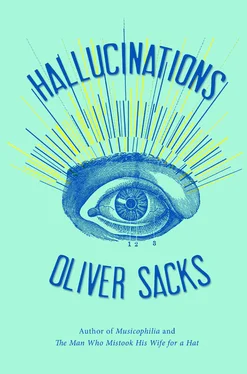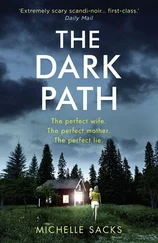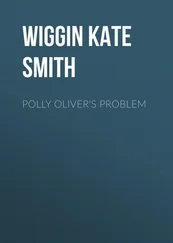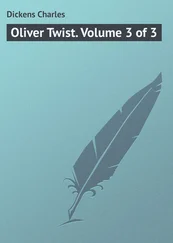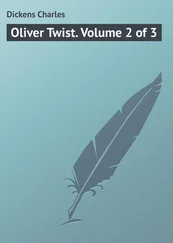There had never before been direct evidence of such a correlation between the contents of a hallucination and the particular areas of cortex activated. We have long known, from observation of people with specific injuries or strokes, that different aspects of visual perception (color perception, face recognition, movement perception, etc.) depend on highly specialized areas of the brain. Thus, for example, damage to a tiny area of the visual cortex called V4 may knock out color perception but nothing else. Ffytche’s work is the first to confirm that hallucinations make use of the same visual areas and pathways as perception itself. (Ffytche has emphasized more recently, in papers on the “hodology” of hallucinations, that attributing hallucinations, or any cerebral function, to specific brain regions has its limitations, and that one must pay equal attention to the connections between these areas.) 11 11 Such correlations involve sizable regions of the brain; they are at a macro level. Correlations on a micro level, at least for elementary geometric hallucinations, have been proposed by William Burke, a neuro-physiologist who has experienced such hallucinations himself, due to macular “holes” in both eyes. He has been able to estimate the visual angles subtended by specific hallucinations and to extrapolate these into cortical distances. He concludes that the separation of his brickwork hallucinations corresponds to the separation of the physiologically active “stripes” in the V2 part of the visual cortex, while the separation of the dots he hallucinates corresponds to that of the “blobs” in the primary visual cortex. Burke hypothesizes that with diminished input from his damaged maculas, there is diminished activity in the macular cortex, releasing spontaneous activity in the cortical stripes and blobs that give rise to hallucinations.
But while there are neurologically determined categories of visual hallucination, there may be personal and cultural determinants, too. No one can have hallucinations of musical notation or numbers or letters, for example, if they have not actually seen these at some point in real life. Thus experience and memory may influence both imagery and hallucination — but with CBS, memories are not hallucinated in full or literal form. When people with CBS hallucinate people or places, they are almost never recognizable people or places, only plausible or invented ones. CBS hallucinations give one the impression that, at some lower level, in the early visual system, there is a categorical dictionary of images or part images — of generic “noses,” for example, or “headwear” or “birds,” rather than of particular noses or headwear or birds. These are, so to speak, the visual ingredients called upon and used in the recognition and representation of complex scenes — elements or building blocks which are purely visual, without context or correlation with other senses, without emotion or particular associations of place or time. (Some researchers have called them “proto-objects” or “proto-images.”) In this way, CBS images seem more raw, more obviously neurological, not personal like those of imagination or recollection.
Hallucinations of text or musical scores are intriguing in this regard, for although they initially look like real music or text, they quickly reveal themselves to be unreadable, in the sense that they have no shape, no tune, no syntax or grammar. Although Arthur S. at first thought he might be able to play his hallucinatory musical scores, he soon realized that he was seeing “a potpourri of musical notation, without any meaning.” Similarly, text hallucinations lack meaning; they may, on closer inspection, not even be actual letters but letter-like runes.
We know (from studies by ffytche and his colleagues) that text hallucinations go with hyperactivity in the visual word form area; there are probably analogous (though more widespread) activations with hallucinations of musical notation, though these have yet to be “caught” on fMRI. In the normal process of reading text or scores, what is initially deciphered in the early visual system goes on to higher levels where it acquires syntactical structure and meaning. But in hallucinations of text or scores, caused by anarchical hyperactivity in the early visual system, letters, proto-letters or musical notation appear without the normal constraints of syntax and meaning — providing a window into both the powers and the limitations of the early visual system.
Arthur S. saw musical notation of fanciful elaboration, far more ornate than any real score. CBS hallucinations are often fanciful or fantastical. Why should Rosalie, a blind old woman in the Bronx, see figures in “Eastern dress”? This strong disposition to the exotic, for reasons we do not yet understand, is characteristic of CBS, and it would be fascinating to see whether this varies in different cultures. These strange, sometimes surreal images, of boxes or birds perched atop people’s heads or flowers coming out of their cheeks, make one wonder whether what is occurring is a sort of neurological mistake, a simultaneous activation of different brain areas, producing an involuntary, incongruous collision or conflation.
The images of CBS are more stereotyped than those of dreams and at the same time less intelligible, less meaningful. When Lullin’s notebook, lost for a century and a half, resurfaced and was published in a psychology journal in 1902 (just two years after Freud’s Interpretation of Dreams ), some wondered whether the hallucinations of CBS might afford, as Freud felt dreams did, “a royal road” to the unconscious. But attempts at “interpreting” CBS hallucinations in this sense bore no fruit. People with CBS had their own psychodynamics, of course, like everyone else, but it became apparent that little beyond the obvious was to be gained from analyzing their hallucinations. A religious person might hallucinate praying hands, among other things, or a musician might hallucinate musical notation, but these images scarcely yielded insights into the unconscious wishes, needs, or conflicts of the person.
Dreams are neurological as well as psychological phenomena, but very unlike CBS hallucinations. Dreamers are wholly enveloped in their dreams, and usually active participants in them, whereas people with CBS retain their normal, critical waking consciousness. CBS hallucinations, even though they are projected into external space, are marked by a lack of interaction; they are always silent and neutral — they rarely convey or evoke any emotion. They are confined to the visual, without sound, smell, or tactile sensation. They are remote, like images on a cinema screen in a theater one has chanced to walk into. The theater is in one’s own mind, and yet the hallucinations seem to have little to do with one in any deeply personal sense.
One of the defining characteristics of Charles Bonnet hallucinations is the preservation of insight, the realization that a hallucination is not real. People with CBS are occasionally deceived by a hallucination, especially if it is plausible or contextually appropriate. But such mistakes are quickly realized to be such, and insight is restored. The hallucinations of CBS almost never lead to persistent false ideas or delusions.
The ability to evaluate one’s perceptions or hallucinations, however, may be compromised if there are other underlying problems in the brain, especially those which impair the frontal lobes, since the frontal lobes are the seat of judgment and self-evaluation. This may happen transiently, for example, with a stroke or head injury; fever or delirium; various medications, toxins, or metabolic imbalances; dehydration or lack of sleep. In such cases, insight will return as soon as cerebral function returns to normal. But if there is an ongoing dementia, like Alzheimer’s or Lewy body disease, there may be less and less ability to recognize hallucinations as such — which, in turn, may lead to frightening delusions and psychoses.
Читать дальше
